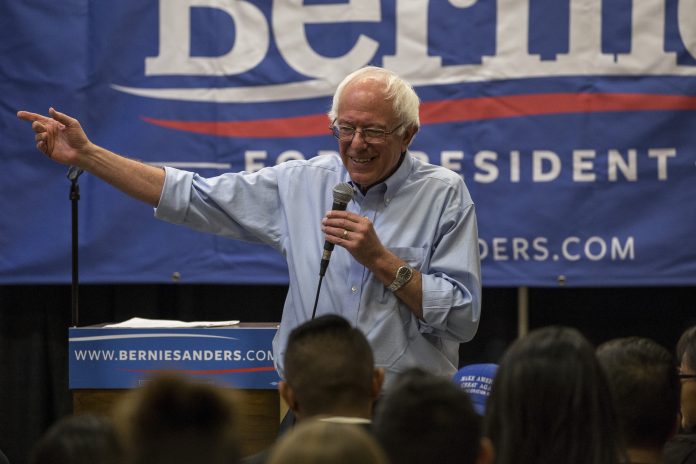For much of the last two years many Democratic insiders and pundits, including me, viewed Bernie Sanders as a less formidable candidate for the Democratic nomination in 2020 than he had been in 2016. Sanders, according to this view, had benefited both from his progressive positions that resonated with many primary voters but also by being the only significant opponent to Hillary Clinton. Thus, the large number of voters who were sick of the Clintons, found her too moderate or for whom sexism prevented from voting for a woman for the highest office in the land, gravitated to Sanders and drove up his support. In a multi-candidate field, according to this argument, Sanders voters would be dispersed among many different candidates who, like the Senator from Vermont, were not Hillary Clinton.
In the weeks since announcing his candidacy, Sanders had turned this logic on its head and may prove many of the pundits wrong. It may be that in 2016, it was not Sanders who consolidated the anti-Clinton sentiment, but Clinton who consolidated the anti-Sanders sentiment. As the primaries went on voters who found Sanders too far left, did not like his inability and seeming unwillingness to connect to non-white voters, or chafed at the sexism of many in his campaign, had nowhere to go but to Clinton. In 2020, according to this view, the vote that went to Clinton will be dispersed among all the other candidates while Sanders will hold his base. If that happens, Sanders will be in a very good position to win the nomination.
It may be that in 2016, it was not Sanders who consolidated the anti-Clinton sentiment, but Clinton who consolidated the anti-Sanders sentiment
The first votes in the primary season will not be cast, or caucused, for another eleven months, but the early indicators look very good for Sanders. Almost all polls show him second only to former vice-president Joseph Biden, but Biden has not yet decided whether or not he is running. However, most of these polls show Sanders ten points ahead of any of the other candidates currently in the race. It is still early for these polls to be very meaningful, but in a multi-candidate race, the name recognition that contributes so much to polling numbers at this point is a valuable commodity for which other candidates will have to spend money-in many cases money they do not yet have.
Sanders, on the other hand, has raised about $10 million dollars from 360,000 donors, much more than any of the current candidates. Sanders will need to raise much more money over the course of the campaign, but his success in this regard thus far allows him to begin campaigning in earnest, but is also a measure of the breadth of his support. The first test for any presidential candidate is whether or not they can raise enough money. Sanders has already passed this test. Other candidates, such as California Senator Kamala Harris will be able to do this too, as will Biden should he decide to run, but some people who have already announced their candidacy will fade away before or immediately after the Iowa caucus if their fundraising remains anemic.
For many Democrats the idea of Sanders winning the nomination and the ensuing general election campaign between Trump and Sanders is concerning. For some Sanders is simply too far left, but for many others Sanders did not make a good impression in 2016 because of his style, insensitivity to issues race and gender in the Democratic Party coalition and perceived lukewarm support for Hillary Clinton after she wrapped up the nomination. These factors drive Sanders’s negatives, which among Democrats are higher than for any other candidate. Additionally, Sanders inability to generate broad support among African Americans, the largest part of the Democratic Party base, is reason to believe he might not be the strongest general election candidate.
This puts Democratic voters and the party leadership, such as it is, in a quandary. Pushing too hard to stop Sanders, at the moment the presumptive frontrunner, would possibly cause big divisions within the party and might not even be effective. However, should Sanders be nominated, there is a real chance that critical parts of the party base will not be enthused about the candidate.
Pushing too hard to stop Sanders, at the moment the presumptive frontrunner, would possibly cause big divisions within the party and might not even be effective
The primary thing that will determine whether or not Sanders converts his early lead into the nomination is not whether he is too far left-he isn’t-or whether Biden or somebody else comes in to save the party and capture the nomination by acclamation-they won’t, but how long the field remains this large. If there are still ten viable candidates for the Iowa caucus and New Hampshire primary and eight or more on March 3rd of 2020 when Texas, California and several other states hold their primary, Sanders will likely be the nominee. However, if that field thins out quickly Sanders will be in trouble.
The best candidate against a deeply unpopular incumbent President is not somebody who, like Sanders, evokes strong feelings of support and disdain within the Democratic Party, but somebody who may be beloved by only a few, but with whom everybody can live. It is not yet clear who that candidate might be, but the frontrunner is clearly not it.
www.lincolnmitchell.com
Follow me on Twitter at: http://twitter.com/LincolnMitchell

